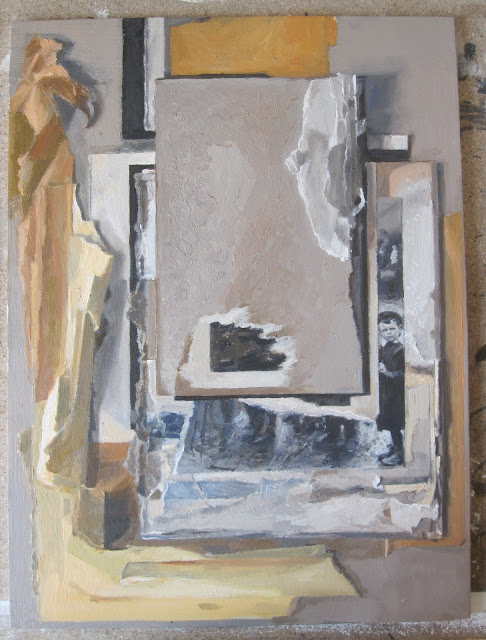work in progress. oil paint on wood.
This statement by Francois Jullien got me thinking....
"In deciding to call the image on the retina not 'imago' but 'pictura', Johannes Kepler connected painting and vision even more intimately. No longer is painting the image of vision; now vision is already in the image of painting. Ut pictura, ita visio: since visual perception is itself an act of representation, it follows that seeing is (already) drawing. And it is that image, not the image rendered in perspective but the optical image- the world "painted" on the retina - that the Dutch painter paints. "
Page 161 chapter 11 'Gaze or Contemplation'. 'The Great Image Has No Form or On the Nonobject through Painting'
If visual perception of 'reality' is based on the mind interpreting (both consciously and/or unconsciously) 'pictures' projected onto the retina through optical mechanics, like a camera obscura, then we are close to Plato's 'Allegory of the Cave'
'Plato has Socrates describe a group of people who have lived chained to the wall of a cave all of their lives, facing a blank wall. The people watch shadows projected on the wall by things passing in front of a fire behind them, and begin to ascribe forms to these shadows. According to Plato's Socrates, the shadows are as close as the prisoners get to viewing reality. He then explains how the philosopher is like a prisoner who is freed from the cave and comes to understand that the shadows on the wall do not make up reality at all, as he can perceive the true form of reality rather than the mere shadows seen by the prisoners.' wikipedia
So how do the 'true lies' of the flat oil painted trompe l' oeil, a fabrication of mirrors and shadows, a trick of the eye masquerading as something real, function in relation to this; what are they saying and how should we 'read' them ?
If the picture projected onto the retina is already an "illusion" then the trompe l' oeil with its pictures inside pictures, is an illusion of an illusion based on direct observation of a 'reality' which is itself an illusion.......... confusing?
The Zen Buddhist, Thich Nhat Hanh says;
"Things in their true nature and illusions are of the same basic substance"
What we hold at face value to be 'true' turns out to be only an appearance of 'reality', which is not to say there is no 'truth' or 'reality' but we should be careful of trying to pin it down in words and pictures which can only circumscribe it or define it negatively as 'not this'. We are at the limits of 'language', written and 'visual'.
Traditionally in Western art, and especially in the 17th century Dutch Calvinist context, trompe l'oeil painting operated as a particular form of 'Vanitas' still-life genre. It had a classical Stoic ethical character, reflecting on the transient nature of sensual pleasures and desires, especially for beauty, food, riches and worldly power. These are presented allegorically as 'illusions' which are less real than their skilfully rendered appearance in the painting and much more transitory.
Painting by its very nature is concerned with aesthetic pleasures, with desire for 'the beautiful' as well as 'the good'. In Protestant Holland it could perhaps very easily have been seen as a vanity in itself but the 17th century painter might allude to Plato's 'Symposium' and the Neo-Platonic idea that attraction to beauty can lead by degrees of realisation towards desire for wisdom in a philosophical sense and insight into the deeper nature of reality and truth.
The painting below is by the Flemish artist, Cornelis Norbetus Gysbrechts. Born in Antwerp he was active in the second half of the 17th century. I love his attention to the texture of the wood surface with the carefully rendered splinters and cracks and his muted, restrained colours with various whites, greys and browns and the wry humour of the painted dripping paint on his palette. He is clearly a 'painter's painter' and this picture with its references to music, painting and writing, hung like trophies, is an allegory of art and the artist's 'self' as much as it is about the mirrors and shadows of illusions and vanities
Cornelis Norbertus Gysbrechts
Trompe l'oeil with violin, painter's implements and self-portrait (1675),


No comments:
Post a Comment